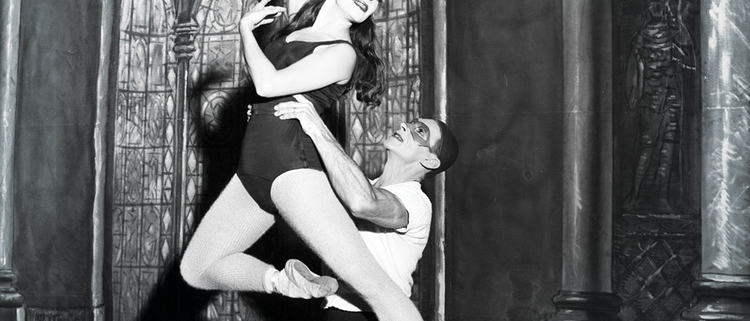Los Angeles choreographers create open-air dance performances

Pedestrians in the McCarthy Quad, Alumni Park and E.F. Hutton Park will find their regular routes obstructed Thursday at noon by crowds who come to watch the work of Los Angeles-based artists in the Visions and Voices program “Dancing the Archives: Emerging Choreographers and Living History.”
Professors Alison D’Amato and Patrick Corbin from the Glorya Kaufman School of Dance and Timothy Stanton from USC Libraries, have been organizing this event since early 2019. Their goal was to host an outdoor exhibition that shows students what they can create using the video and visual materials from the recently debuted USC Dance Heritage Video Archive and similar library materials.
L.A.-based artists Chris Emile, Jinglin Liao and Marina Magalhães, who were selected from an application process, were encouraged to use the DHVA, the USC ONE National Gay and Lesbian Archives, the California Historical Society Collection and the Los Angeles City Archives to inspire their new work specific to their presentation locations at the University Park Campus.
“This is just sort of an access point to research in general and using archive material for research whether it’s [for] research to do a performative piece or a paper or an article, whatever you’re doing … in any area of study,” Corbin said. “Our entry point is dance, so we thought that that would be … a fun way to get people in to start engaging with archives in general.”
In addition to engaging with the archives, artists will interact with their chosen sites to create original performances catered to their surroundings. Interaction with audience members and surrounding elements will look different depending on each artist’s creative vision.
Liao said she will use this freedom to pull passersby from the high-traffic crossroads of McCarthy Quad and transport the audience to the center of her piece during the middle of her performance. Magalhães said she will use her dancing outdoors as a way to connect to tradition and spawn memory to land that once belonged to other people.
“It’s not like going to a theater and seeing a dance that would look the same in this theater as it would across town, as it would in another state,” D’Amato said. “These are works that are responding to the location.”
Location is an especially important concept for Magalhães, who used DHVA artist Tonio Guerra’s piece “Snip, Rip, Rumble” in combination with topographical maps and materials that show the relationships between Native Americans and early settlers in California. Magalhães said her work draws upon her relationship with her birthplace in Brazil and discussions about privilege, and she was especially interested in creating a piece that drew upon similar themes of ancestry and diaspora for Thursday’s upcoming performance.
“We’re dancing under a big open sky, there’s trees, the elements are super present,” Magalhães said. “Something that I work with a lot is being able to pull from my own African and indigenous ancestry, as a Latin American person, to inform the dance practice and understanding that a lot of these ancestral spiritual traditions are connected to the earth, and understanding that these elements are sacred and we are extensions of these elements, and therefore our bodies are also sacred.”
Through her piece “Circular” or “Circling Home,” Magalhães said she hopes to create a performance that prompts viewers to question their individual journeys, purpose and relationship with the ground under them. Her work asks audiences to rethink their assumptions, their motives and the extent to which they connect with their ancestral lineage.

“I believe there is no such thing as apolitical art,” Magalhães said. “I think all art is political. Even the very decision to call yourself an apolitical artist is already a political stance, so I think it’s inevitable that all performance, all art, is evoking a certain kind of politics.”
Liao takes a different approach to choreographing her work. The artist said she draws inspiration from animals’ sensitivity, robotic movements and rapid decisions between action and inaction.
“I follow the muscle and sometimes, I need to stop and I need jump out of this and then [into] something new,” Liao said. “There’s always … an outside eye who is watching. And for me, when I’m dancing, sometimes I’m completely inside it and sometimes I’m jumping out of myself and watching myself dancing.”
Inspired by Latsky and Goldhuber’s piece “I Hate Modern Dance” in the DHVA, Liao introduces playfulness and audience participation in her work. Her piece aims to engage the audience as it moves viewers around McCarthy Quad, and dancers may draw clueless passersby into the evolving performance as Liao and another dancer act and react to the busy campus around them.
Liao said she was inspired by the emphasis on action and reaction in the archival materials she used and that her performance will employ similar gestures that act upon passersby and respond to their unpredictable reactions. Because it is impossible to choreograph strangers’ movements, the duet must improvise its performance as it navigates McCarthy Quad and its paths and daily traffic that ceases for no one.
Following the open-air performances, a panel featuring the artists and moderated by choreographer Bebe Miller will discuss the ways students and community members can embark on their own projects using tools in the DHVA.
“Bebe is really well-known for doing projects that engage with questions around not only the documentation of choreographic work but how that can take new life,” D’Amato said. “So it’s not just about having a dance that gets documented and preserved and kind of locked away, but it’s really about engaging with the practice of archival and engaging with questions about memory and its relationship to the body.”
Corbin and D’Amato hope that this visual display will inspire students to conduct their own research and create similar original pieces within their own disciplines.

